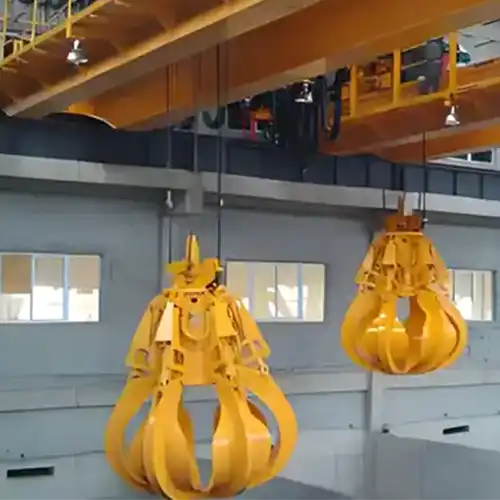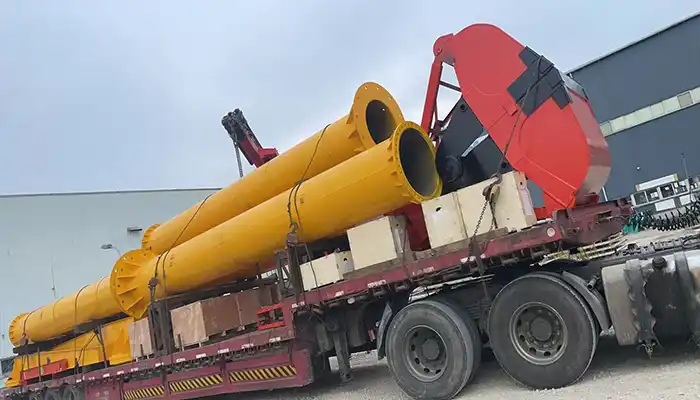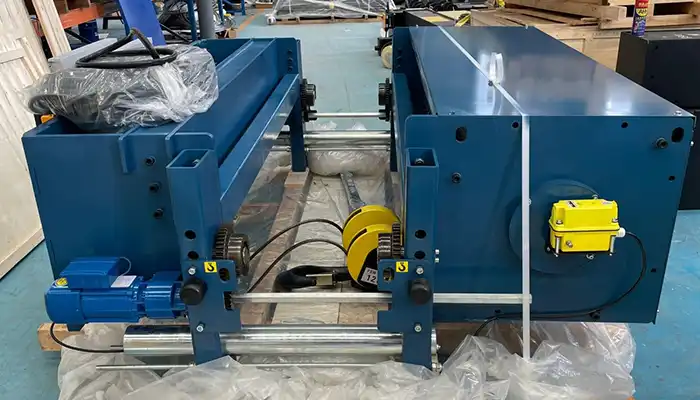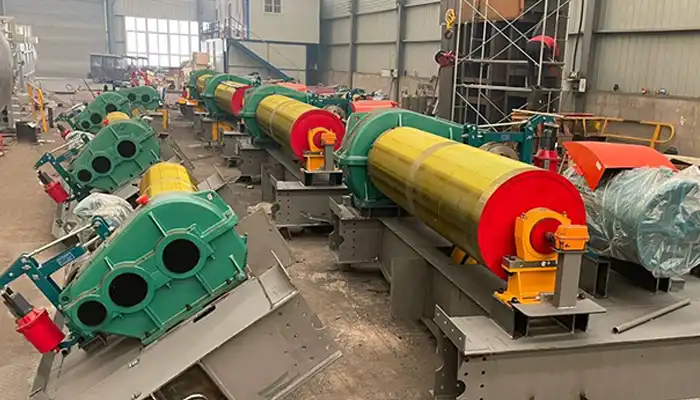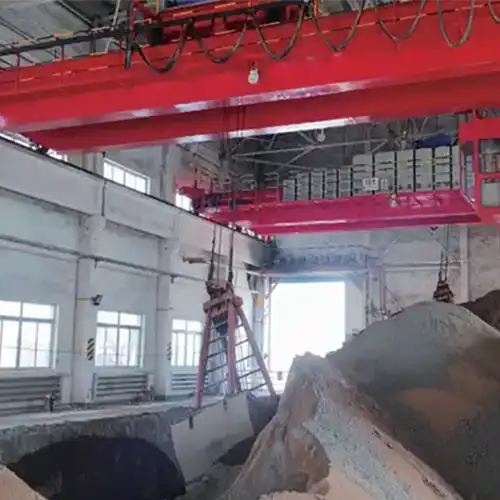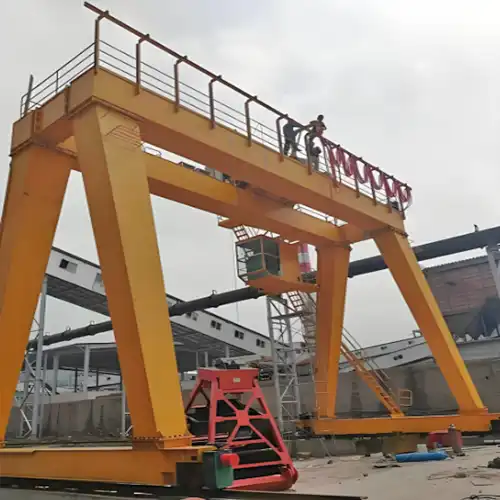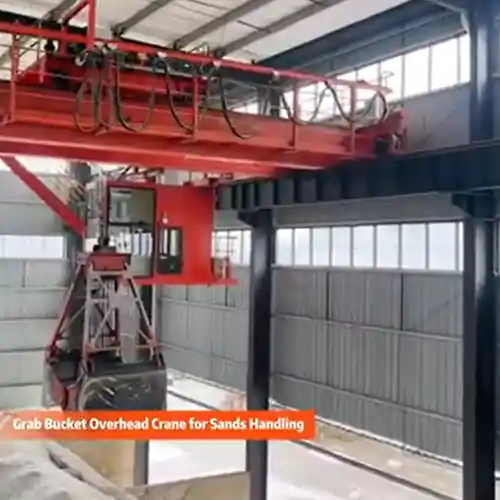Hydraulic Grab Bucket Overhead Crane for Smart Material Handling
Hydraulic grab bucket crane for sale. Hydraulic grab bucket overhead crane, designed for seamless bulk material handling in demanding industrial operation.
Category: Grab Crane
Your Trusted Overhead Grab Bucket Crane Manufacturer & Supplier
Hydraulic Grab Bucket Overhead Crane for Smart Material Handling
Hydraulic grab bucket crane for sale.Maximize efficiency with hydraulic grab bucket overhead cranes, designed for seamless bulk material handling in demanding industrial operations.
Hydraulic Grab Bucket Overhead Cranes
Hydraulic grab bucket overhead cranes are specialized lifting machines. They use a hydraulic system to control a bucket that grabs, lifts, and dumps materials. These cranes are popular in environments where bulk material handling is common. They are highly efficient and provide precision in lifting heavy and loose materials.
These cranes are used in various industries, such as steel mills, construction sites, and ports. They are designed to work in tough conditions, making them versatile tools for lifting and transporting materials.
Importance of Hydraulic Grab Buckets in Material Handling and Lifting Operations
The overhead grab bucket crane is crucial for handling materials that are hard to manage with regular lifting tools. These include scrap metal, coal, sand, and other bulk items. The hydraulic system makes it easy to control the grab bucket, ensuring accuracy when lifting and placing materials.
Unlike traditional mechanical grabs, hydraulic grabs can handle much heavier loads and operate faster. This makes the crane more effective in busy and high-demand environments, reducing downtime and improving productivity.
Primary Applications in Industries
- Steel Mills: Hydraulic grab bucket cranes are often used to handle scrap metal. The grab bucket can pick up large amounts of metal waste, helping to recycle and move materials quickly. These cranes also play a role in loading raw materials into furnaces or transporting molten metal.
- Shipyards: These cranes are perfect for handling bulk cargo like coal, ore, or grain. The hydraulic grab bucket is strong enough to lift large amounts of material onto ships or from ships onto the dock.
- Construction Sites: In construction, these cranes are used for lifting and moving materials like sand, gravel, and concrete. The grab bucket’s ability to pick up and dump large loads quickly helps speed up the building process.
- Waste Management: Hydraulic grab bucket cranes are also used in waste management to lift and move waste materials. Whether it’s for recycling or disposal, the crane can efficiently move large volumes of waste.
In all of these industries, hydraulic grab bucket overhead cranes offer unmatched precision and efficiency, making them a go-to tool for heavy lifting tasks.
What is a Hydraulic Grab Bucket Overhead Crane?
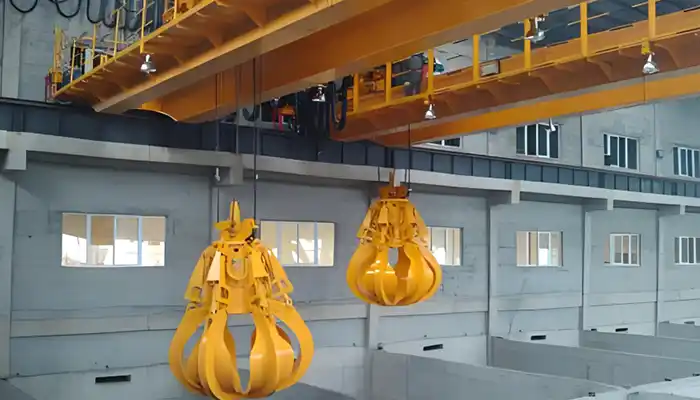
Definition and Key Features
A hydraulic grab bucket overhead crane is a lifting machine designed to handle bulk materials using a hydraulic-powered grab bucket. The crane's key feature is its ability to efficiently grab, lift, and dump materials like scrap metal, coal, or sand. The hydraulic system controls the grab bucket, allowing precise operation with minimal effort.
The crane's overhead design allows it to move materials across a large area, often over workstations or production lines. It can operate in tight spaces, making it suitable for various industrial environments. The hydraulic grab bucket can be customized based on the specific material it's designed to handle, such as different shapes and sizes of buckets.
Difference Between Traditional Cranes and Those with Hydraulic Grab Buckets
- Traditional Cranes: These cranes rely on mechanical means to lift and move materials. They may use hooks, slings, or simple grabs to handle loads. While effective, they can be slower and less precise, especially with loose or irregularly shaped materials.
- Hydraulic Grab Bucket Cranes: These cranes have an added hydraulic system that controls the grab bucket. The hydraulic system offers greater power and precision, allowing the bucket to open and close automatically with high force. It can also handle heavier and more complex materials with greater accuracy than traditional cranes.
In simple terms, hydraulic grab bucket cranes combine the strength of hydraulics with the efficiency of an overhead crane, making them ideal for high-demand, bulk material handling.
Components of a Hydraulic Grab Bucket Overhead Crane
- Grab Bucket: The grab bucket is the key part of the crane. It is designed to grab and hold materials. The bucket is controlled by a hydraulic system, which allows it to open, close, and lift material efficiently. The design of the bucket can vary depending on the material being handled (e.g., single or multi-rope grab for different tasks).
- Crane Structure: The crane structure includes the frame, trolley, hoist, and track system. It is typically made from heavy-duty steel to handle the weight of the materials and the forces exerted by the hydraulic system. The crane structure is designed for stability and long-lasting operation.
- Hydraulic System: This system powers the grab bucket. It consists of pumps, valves, and hoses that control the movement of the bucket. The hydraulic system is what gives the crane its strength and precision. It's essential for efficiently controlling the opening, closing, and lifting of the grab bucket under heavy loads.
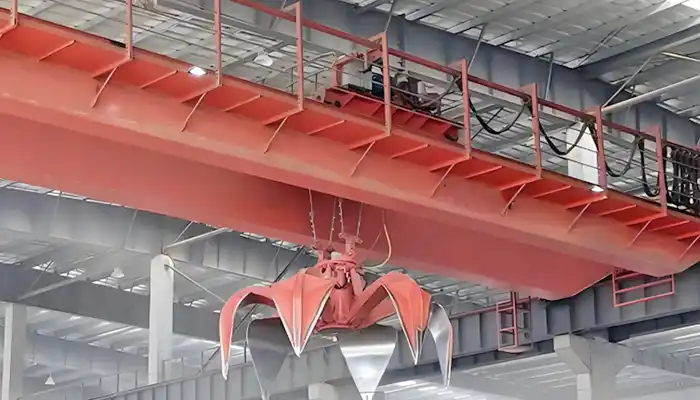
Together, these components work in harmony to allow the crane to perform complex material handling tasks with efficiency and ease. The hydraulic grab bucket crane’s design ensures that it can move large, heavy, and irregularly shaped materials quickly and safely.
QZ Series Double Girder Overhead Crane with Hydraulic Grab Bucket | ||
Working Class |
| A5~A6 |
Capacity | t | 3~20 |
Span | m | 10.5m to 34.5m |
Lifting Height |
| As your request |
Lifting Speed | m/min | 6~15.6,Single or Dual Speed |
Trolley Travelling Speed | m/min | 20~44.6,Single or VFD |
Crane Travelling Speed | m/min | 40~125,Single or VFD |
Control Method |
| Remote control, Cab Control or as your request |
Power Supply |
| 380V 50HZ 3 Phase or Customized |
Temperature | ℃ | -20~60 |
Protection Grade |
| IP54~65 |
Optional Spreader |
| Grab buckets, the orange grab and clamshell grab, motorized grab, mechanical grab, and hydraulich grab, etc. |
The above are standard parameters, and customized solutions and designs are provided according to your actual needs. | ||
Working Mechanism of Hydraulic Grab Bucket
How the Hydraulic System Operates to Control the Grab Bucket
The hydraulic system plays a central role in the operation of a hydraulic grab bucket crane. It uses hydraulic fluid to transfer energy and operate the grab bucket. Here's how it works:
- Hydraulic Pump: The system starts with a hydraulic pump, which pressurizes hydraulic fluid. This fluid flows through hoses to the hydraulic cylinders.
- Hydraulic Cylinders: The cylinders are the key to the bucket’s movement. When hydraulic fluid is pumped into the cylinder, it causes the piston inside to move. This movement opens or closes the grab bucket. The force generated by the hydraulic fluid allows the bucket to handle heavy loads easily.
- Valves and Control System: The crane operator uses a control system, usually a joystick or buttons, to direct the flow of hydraulic fluid. By adjusting the valves, the operator can control the speed and force of the bucket’s opening and closing, providing precise handling of materials.
This hydraulic operation makes it easier to lift and handle bulk materials compared to manual or mechanical grabs. It’s efficient and effective, especially when working with heavy or irregularly shaped loads.
Types of Hydraulic Grabs
There are different types of hydraulic grabs, each suited for different materials and applications:
- Single Rope Grab: This type of grab uses a single hydraulic rope to control the opening and closing of the bucket. It is often used for handling bulk materials like coal, sand, or gravel. Single rope grabs are simple, cost-effective, and good for lighter material handling.
- Double Rope Grab: This grab uses two ropes, which are controlled hydraulically. The extra rope offers more stability and better control, making it suitable for handling heavier and more complex materials. Double rope grabs are common in ports and steel mills, where larger loads are frequently handled.
- Multi-Rope Grab: This grab has multiple ropes to control the bucket. The multi-rope system provides high precision and is ideal for lifting very heavy or irregular loads. It's often used in demanding environments like shipyards or steel mills, where high-capacity material handling is required.
Each of these grabs can be customized for specific materials, making them versatile for various industries.
Functionality of the Grab Bucket in Material Collection, Handling, and Dumping
The grab bucket performs three main functions: collecting, handling, and dumping materials. Here’s how it works:
- Material Collection: The grab bucket opens wide and is positioned above the material to be collected. It then closes around the material, “grabbing” it securely. The hydraulic system allows the grab bucket to handle loose, irregular materials like scrap metal, coal, or sand.
- Material Handling: Once the bucket has collected the material, it is lifted by the crane hoist. The hydraulic system ensures that the material is handled smoothly, even when the load is heavy or awkwardly shaped. The crane moves the grab bucket to the desired location.
- Material Dumping: After transporting the material to its destination, the grab bucket is tilted or opened to release the material. The hydraulic system allows for controlled dumping, ensuring that materials are unloaded precisely and safely.
These functions allow hydraulic grab bucket overhead cranes to move large amounts of material quickly and efficiently, making them essential in industries like steel mills, ports, and construction sites. The crane's ability to operate with high precision and handle various types of materials makes it a valuable tool in material handling and logistics.
Applications and Use Cases
Steel Mills: Handling Scrap Metal, Loading/Unloading
- Role: In steel mills, hydraulic grab bucket cranes are used primarily for handling scrap metal.
- How It Works: The crane’s grab bucket efficiently picks up and transports scrap metal (such as steel plates, rods, and old machinery) to furnaces for melting or recycling.
- Benefits: The hydraulic system ensures precise handling, reducing manual labor and enhancing safety. These cranes also speed up the loading/unloading process, improving overall productivity in busy steel mill environments.
Shipyards: Bulk Material Handling, Loading Cargo
- Role: Hydraulic grab bucket cranes are essential in shipyards for bulk material handling and cargo loading/unloading.
- How It Works: These cranes are used to handle large quantities of materials like coal, ore, grain, and other bulk items, often with irregular shapes that are difficult to manage using standard equipment.
- Benefits: The grab bucket scoops up materials, and the hydraulic system ensures precise lifting and placement onto ships or docks. This capability improves loading and unloading efficiency, especially when dealing with materials that need to be moved over the side of ships.
Construction Sites: Handling Construction Debris or Aggregates
- Role: On construction sites, these cranes help manage materials like sand, gravel, and debris.
- How It Works: Hydraulic grab bucket cranes are used to collect and transport construction waste or materials, from removing debris to distributing raw materials across the site.
- Benefits: The grab bucket makes material handling faster and more efficient, reducing the need for manual labor. This helps maintain a steady workflow, especially in fast-paced construction environments.
Waste Management: Sorting and Lifting Waste Materials
- Role: In waste management, hydraulic grab bucket cranes are used for sorting, lifting, and transporting waste materials.
- How It Works: The crane’s grab bucket is used to lift large volumes of waste, such as plastics, metals, or general refuse, either for sorting or disposal.
- Benefits: These cranes improve the efficiency of waste handling by reducing manual effort and speeding up the sorting and disposal process. The hydraulic control allows for precise lifting, ensuring that even bulky or heavy waste materials can be easily managed.
By using hydraulic grab bucket cranes in these industries, businesses are able to streamline material handling, improve efficiency, and enhance worker safety. Whether in steel mills, shipyards, construction sites, or waste management, these cranes are an invaluable tool for handling bulk and irregularly shaped materials.
Advantages of Hydraulic Grab Bucket Overhead Cranes
Precision Handling
- Why It Matters: Hydraulic control allows for precise movement of the grab bucket, enabling accurate lifting, dumping, and placing of materials.
- How It Helps: This precision is essential when handling materials that require careful handling, such as scrap metal, chemicals, or delicate materials. The ability to open and close the bucket with high accuracy reduces spillage and ensures materials are moved exactly where needed.
Efficient Material Handling
- Why It Matters: Hydraulic grab bucket cranes are much faster and more efficient than manual or traditional mechanical methods.
- How It Helps: With the power of hydraulics, these cranes can scoop up large amounts of materials in a short amount of time, speeding up the overall workflow. In busy environments like steel mills or construction sites, this efficiency boosts productivity and reduces downtime, ensuring operations run smoothly.
Reduced Wear and Tear
- Why It Matters: Traditional cranes often rely on mechanical components that experience wear over time, leading to frequent repairs and downtime.
- How It Helps: Hydraulic systems reduce the mechanical strain by using fluid pressure to control movements. This lessens the wear and tear on mechanical parts, increasing the lifespan of the crane and lowering maintenance costs. The result is a more reliable and long-lasting crane, especially in high-demand environments.
Customization
- Why It Matters: Every material handling job is different, and different environments have unique demands.
- How It Helps: Hydraulic grab bucket cranes can be customized to meet specific needs. This includes designing the grab bucket for different materials (e.g., metal, waste, grain) or adjusting the crane’s lifting capacity. Whether working in a steel mill, shipyard, or waste management facility, these cranes can be adapted to handle a wide variety of materials and operate in different environments.
These advantages make hydraulic grab bucket overhead cranes a top choice for industries where material handling precision, speed, and reliability are critical. The ability to reduce wear and tear and customize the crane for specific tasks ensures that operations remain efficient and cost-effective over the long term.
Design and Engineering Considerations
Choosing the Right Size and Capacity for the Crane
- Why It Matters: The size and lifting capacity of the crane must match the specific demands of the facility and material types being handled.
- How It Helps: A crane that is too small may struggle to handle the required loads, leading to inefficiency and safety concerns. On the other hand, a crane that is too large can be costly and less efficient for the task. The crane should be sized according to the maximum weight and type of material it will lift, as well as the span and reach needed to cover the work area.
Selecting the Proper Hydraulic System Based on Material Characteristics
- Why It Matters: Different materials require different levels of lifting force, control, and speed, making the selection of the hydraulic system crucial.
- How It Helps: The hydraulic system should be tailored to the type of material being handled. For example, heavier materials like scrap metal require a more powerful hydraulic system to provide the force needed for efficient lifting. Lighter materials, such as sand or grain, might need a less powerful system with greater control for handling. Properly matching the hydraulic system to the material ensures optimal performance and prevents unnecessary wear on the system.
Safety Features
Why It Matters: Safety is a top priority when operating heavy lifting machinery, especially in industrial settings where workers and equipment are in close proximity.
How It Helps: Modern hydraulic grab bucket cranes come equipped with various safety features, such as:
- Overload Protection: Prevents the crane from lifting beyond its safe capacity, reducing the risk of damage or accidents.
- Emergency Stop: A critical feature that allows the crane to be quickly shut down in case of an emergency, preventing potential damage to equipment or injury to workers.
- Anti-Sway Mechanisms: Reduces the swinging of the grab bucket while lifting or transporting materials, improving stability and safety during operation.
Customization Options
Why It Matters: Different industries and material types require specialized tools and designs for maximum efficiency.
How It Helps: Customization options allow for the crane to be tailored for specific tasks and environments. These may include:
- Specialized Grab Buckets: Designed for particular materials like scrap metal, grain, or construction debris. For instance, a multi-rope grab is ideal for lifting heavy or irregularly shaped items, while a single rope grab is suitable for lighter materials.
- Adjustable Lifting Heights: Tailoring the crane’s reach to fit the layout of the workspace or specific material storage locations.
- Environmental Considerations: Cranes can be designed to operate in extreme temperatures, harsh weather conditions, or corrosive environments, ensuring the equipment functions optimally no matter the challenges.
Considering these design and engineering factors ensures that a hydraulic grab bucket overhead crane meets the specific needs of the workplace, operates safely, and performs efficiently for years to come. Choosing the right size, hydraulic system, and customization options guarantees the crane can handle the materials and conditions it’s faced with, improving overall productivity and reducing maintenance costs.
Safety Features and Considerations
Safety Protocols in Operation
- Load Sensing: Load sensing systems monitor the weight of materials being lifted. If the load exceeds the crane’s rated capacity, the system alerts the operator or even automatically stops further lifting to prevent damage or accidents. This feature ensures safe operation under heavy load conditions.
- Anti-Collision Systems: To avoid accidents in crowded or confined areas, anti-collision systems are installed. These sensors detect nearby objects or other cranes, automatically stopping the crane or adjusting its path to prevent collisions. This is especially important in environments like steel mills or shipyards, where cranes often operate in close proximity to each other and workers.
- Other Safety Features: Emergency stop buttons, overload alarms, and automatic locking mechanisms are also critical to preventing accidents. These systems offer immediate responses to prevent equipment failure or dangerous situations during operation.
Regular Maintenance to Ensure Hydraulic and Structural Integrity
- Hydraulic Maintenance: Ensuring that the hydraulic system remains in top condition is essential for safe crane operation. Regular checks for hydraulic fluid levels, pressure, and seals help prevent sudden malfunctions. Routine inspections also focus on the hydraulic hoses and cylinders to avoid leaks and wear.
- Structural Integrity: The crane structure, including the crane frame, hoist, and grab bucket, should be inspected for any signs of wear, cracks, or misalignments. Over time, structural components can degrade due to the forces they experience during operation. Regular inspections ensure the crane operates safely and avoids catastrophic failures.
Operator Training for Safe Handling and Operation
- Why It Matters: Proper operator training is critical for ensuring that the crane is used safely and efficiently.
- How It Helps: Trained operators know how to handle loads within the crane’s limits, respond to safety alerts, and understand maintenance procedures. They are also aware of safe operating practices, including the correct use of the hydraulic system, avoiding overloading, and ensuring the crane operates within its designed parameters.
Maintenance and Care
Importance of Regular Inspection and Maintenance of Hydraulic Systems
- Why It Matters: The hydraulic system is the backbone of the grab bucket crane, controlling its lifting and grabbing capabilities. Without regular inspection and maintenance, it can fail, causing operational delays or even accidents.
- How It Helps: Regular checks for hydraulic fluid levels, fluid cleanliness, pressure settings, and hose integrity help ensure smooth operation. Maintaining the hydraulic system also ensures that the crane operates efficiently, preventing sudden failures that could disrupt operations.
Common Issues and Troubleshooting
- Hydraulic Fluid Leakage: One of the most common issues with hydraulic systems is fluid leakage. This can happen due to damaged seals or hoses. If not addressed, it can lead to a loss of hydraulic pressure and reduced crane performance. Regularly inspecting hoses and seals can help prevent this.
- Bucket Jams: Hydraulic grabs can occasionally become jammed, especially when lifting large or irregularly shaped materials. To avoid this, it’s important to ensure the grab bucket is maintained, free of debris, and operating smoothly. Regular cleaning and lubrication of the moving parts can prevent jams from occurring.
Routine Maintenance Schedules for Hydraulic Components and Crane Structure
Hydraulic Components: A routine maintenance schedule should include:
- Weekly: Check hydraulic fluid levels and perform a basic visual inspection of hoses and cylinders.
- Monthly: Inspect and clean filters, check fluid pressure, and examine the hydraulic pumps for signs of wear.
- Yearly: Perform a complete hydraulic system overhaul, including replacing fluid, seals, and filters if necessary.
Crane Structure: The crane frame, hoist, and grab bucket should be inspected for any structural damage, particularly where wear and tear are most likely, such as joints, welds, and moving parts.
- Weekly: Check for visible cracks or deformations.
- Monthly: Inspect load-bearing components and lubricate moving parts.
- Annually: Conduct a comprehensive inspection to check for any signs of fatigue, misalignment, or rust that could affect crane stability.
Regular maintenance and safety features play an essential role in the reliability and longevity of hydraulic grab bucket overhead cranes. Ensuring that operators are trained, systems are regularly inspected, and safety protocols are followed helps keep operations running smoothly and safely.
Cost Considerations
Initial Cost vs. Long-Term Operational Savings
- Initial Cost: The upfront cost of a hydraulic grab bucket overhead crane can be significant due to the complexity of the hydraulic system, the size and capacity of the crane, and the quality of materials used. Customizations to suit specific operational needs can further increase the initial investment.
- Long-Term Savings: While the initial investment may be high, hydraulic grab bucket cranes can provide substantial long-term savings. These savings come from increased efficiency, reduced labor costs, and fewer manual handling errors. The automation and precision offered by these cranes reduce downtime and the risk of accidents, which ultimately lowers operational costs.
Return on Investment (ROI) Analysis in Industries Like Steel Mills and Ports
- Steel Mills: In steel mills, the ROI from investing in hydraulic grab bucket cranes is often seen through improved scrap metal handling and reduced labor costs. The ability to quickly and safely move large amounts of scrap metal to furnaces or recycling stations boosts productivity. Additionally, the precision of hydraulic systems ensures less waste and fewer accidents, which contributes to cost savings in the long run.
- Ports: In port operations, hydraulic grab bucket cranes are essential for loading and unloading bulk materials. The speed and efficiency of the cranes reduce the time it takes to process ships, which translates into quicker turnaround times and increased throughput. By improving cargo handling capabilities, ports can handle more shipments in a shorter period, improving overall revenue.
- ROI Calculation: ROI can be measured by comparing the crane’s total cost to the additional revenue or savings generated from its use. Over time, this could include reduced labor costs, fewer maintenance issues, and better resource utilization.
Factors Influencing Cost
- Crane Size: Larger cranes with higher lifting capacities tend to have a higher initial cost. The size of the crane should be chosen based on the weight and type of materials being lifted, as well as the workspace constraints. While bigger cranes can lift heavier loads, they may be overkill for smaller operations, leading to unnecessary costs.
- Hydraulic System Complexity: A more complex hydraulic system, especially one tailored for heavy-duty operations or special materials, can increase the cost of the crane. Features such as multi-rope grabs, advanced load sensing, and more precise hydraulic control systems come with additional costs but offer better performance and longevity.
- Customization: Customization options, such as specialized grab buckets for different materials (e.g., scrap metal, waste, bulk cargo), and modifications for specific environmental conditions (e.g., corrosion-resistant materials for coastal areas) can significantly influence the overall cost. However, these customizations ensure the crane meets the unique demands of the operation, enhancing its efficiency and lifespan.
When considering the total cost of a hydraulic grab bucket overhead crane, it’s important to balance the initial investment against the long-term savings and productivity improvements it brings. While the upfront cost might be high, the efficiency, safety, and reduced labor costs often provide a significant return on investment over the lifespan of the crane. Key factors like crane size, hydraulic system complexity, and customization will influence the total cost, but careful selection based on operational needs will maximize the crane’s value.
Conclusion
Hydraulic grab bucket overhead cranes provide substantial benefits across various industries, including steel mills, shipyards, construction sites, and waste management. These cranes excel at precision handling, improving material handling efficiency, and reducing the physical labor required for heavy lifting. Their hydraulic control system enables accurate lifting and dumping of materials, while their ability to handle bulk and irregularly shaped loads makes them indispensable in environments where efficiency and safety are critical. With their versatility, hydraulic grab bucket cranes play an essential role in streamlining operations and increasing productivity.
Selecting the right hydraulic grab bucket crane is crucial for maximizing efficiency and safety. The crane must be tailored to the specific material handling needs of the facility, taking into account factors like load capacity, material characteristics, and the layout of the workspace. Choosing the appropriate crane ensures that operations run smoothly, minimizes downtime, and avoids the risks associated with overloading or using the wrong equipment for the job.
Automation in Hydraulic Crane Technology and Innovations
As technology continues to evolve, hydraulic crane systems are likely to see several innovations. Some potential future trends include:
- Automation and Smart Features: With the rise of automation, hydraulic cranes will likely become more integrated with smart technologies. Features like remote monitoring, predictive maintenance, and AI-based load management could further enhance crane performance and reduce human intervention.
- Energy Efficiency: Advances in hydraulic systems could lead to more energy-efficient cranes, using less power while maintaining high lifting capabilities. This would be beneficial for reducing operational costs and minimizing the environmental impact.
- Enhanced Safety: Ongoing improvements in safety technologies, such as real-time load sensing, advanced anti-collision systems, and enhanced emergency response features, will make these cranes even safer for operators and facilities.
- Customization and Flexibility: Future innovations will likely focus on providing even more customization options for hydraulic grab bucket cranes, enabling them to handle a wider range of materials and work in diverse environments, from extreme temperatures to high-risk areas.
As hydraulic grab bucket overhead cranes continue to evolve, their role in industrial operations will only grow, offering more efficient, safer, and cost-effective solutions for material handling.
Main Projects
Related Products
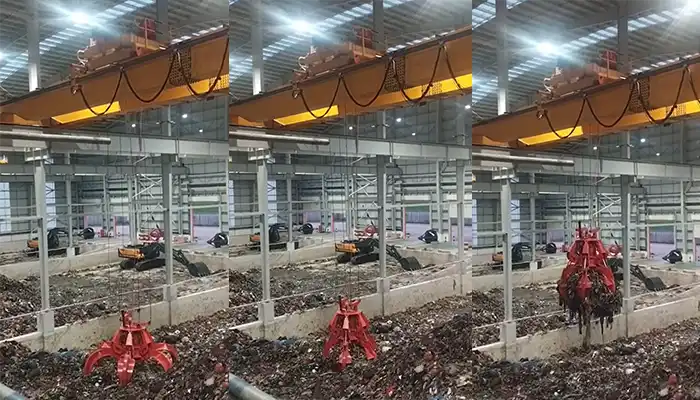
Supplied three grab bucket crane kits to Indonesia, enhancing garbage handling efficiency with high load capacity and reliable performance.
Free consultation to Confirm Parameters & Specifications and Get
Latest Crane Price & Crane Rate.
- Types of overhead cranes : _______?
- Optional: Overhead travelling crane, goliath gantry crane,Slewing jib crane, Single girder or double girder crane,small portable crane or kbk crane, etc.
- Capacity of overhead crane: _______?
- Optional: 0.25ton, 0.5 ton, 1 ton, 2 ton, 3ton, 5 ton, 10 ton,15ton, 20ton, 25 ton, 30ton,35ton, up to 550ton, etc.
- Crane span & lifting height : _______?
- Crane travelling length : _____?
- Control of overhead crane:_______?
- Optional: pendant/ remote/cabin control
- Voltage supply of overhead crane:_____?
- Eg,: 380V50/60HZ,3Phase or others,etc.
- Application/usage of crane:_______?
- Eg,: Steel mill, ,injection mold, cement,stone, concrete,granite, general manufacturing, etc.
Just leave a message via the contact form and our hoist and crane engineer will contact you with in 24working hours.
Get In Touch
